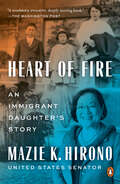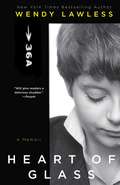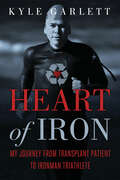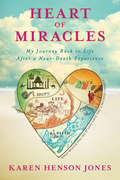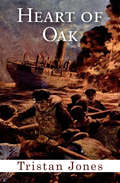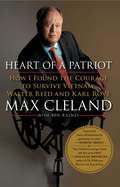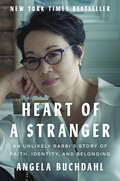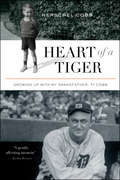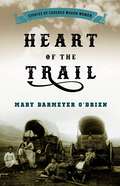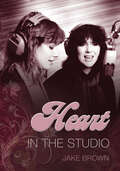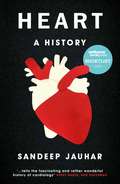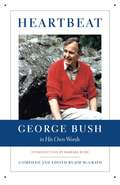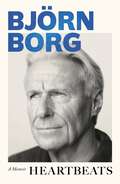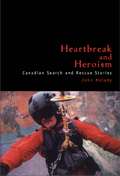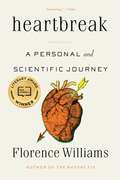- Table View
- List View
Heart of Fire: An Immigrant Daughter's Story
by Mazie K. Hirono"[A] sparkling, revelatory memoir.&” —Oprah Daily&“[A] multigenerational tale...built around her political and feminist awakening…Most powerfully, Heart of Fire is about Hirono&’s growing determination to loosen her tongue.&” –Rebecca Traister, The Cut&“Inspiring . . . insightful . . . you won&’t want to put it down.&” —CosmopolitanThe intimate and inspiring life story of Mazie Hirono, the first Asian-American woman and the only immigrant serving in the U.S. SenateMazie Hirono is one of the most fiercely outspoken Democrats in Congress, but her journey to the U.S. Senate was far from likely. Raised on a rice farm in rural Japan, she was seven years old when her mother, Laura, left her abusive husband and sailed with her two elder children to Hawaii, crossing the Pacific in steerage in search of a better life. Though the girl then known as "Keiko" did not speak or read English when she entered first grade, she would go on to serve as a state representative and as Hawaii's lieutenant governor before winning election to Congress in 2006. In this deeply personal memoir, Hirono traces her remarkable life from her earliest days in Hawaii, when the family lived in a single room in a Honolulu boarding house while her mother worked two jobs to keep them afloat, to her emergence as a highly effective legislator whose determination to help the most vulnerable was grounded in her own experiences of economic insecurity, lack of healthcare access, and family separation. Finally, it chronicles Hirono's recent transformation from dogged yet soft-spoken public servant into the frank and fiery advocate we know her as today.For the vast majority of Mazie Hirono's five decades in public service, even as she fought for the causes she believed in, she strove to remain polite and reserved. Steeped in the nonconfrontational cultures of Japan and Hawaii, and aware of the expectations of women in politics--chiefly, that they should never show an excess of emotion--she had schooled herself to bite her tongue, even as her male colleagues continually underestimated her. After the 2016 election, however, she could moderate herself no longer. In the face of a dangerous administration--and amid crucial battles with lasting implications for our democracy, from the Kavanaugh hearings to the impeachment trial--Senator Hirono was called to give voice to the fire that had always been inside her. The compelling and moving account of a woman coming into her own power over the course of a lifetime in public service, and of the mother whose courageous choices made her life possible, Heart of Fire is the story of a uniquely American journey, told by one of those fighting hardest to ensure that a story like hers is still possible in this country.
Heart of Glass: A Memoir
by Wendy LawlessIn this edgy and romantic follow-up to her New York Times bestselling debut memoir, Chanel Bonfire, Wendy Lawless chronicles her misguided twenties--a darkly funny story of a girl without a roadmap for life who flees her disastrous past to find herself in the gritty heart of 1980s New York City.Before downtown Manhattan was scrubbed clean, gentrified and overrun with designer boutiques and trendy eateries and bars, it was the center of a burgeoning art scene--both exciting and dangerous. Running from the shipwreck of her glamorous and unstable childhood with a volatile mother, Wendy Lawless landed in the center of it all. With an open heart and a thrift store wardrobe, Wendy navigated this demi-monde of jaded punk rockers, desperate actors, pulsing parties, and unexpected run-ins with her own past as she made every mistake of youth, looked for love in all the wrong places, and eventually learned how to grow up on her own. With the same "biting humor" (People) that made her "powerful" (USA TODAY) and "illuminating and inspiring" (Reader's Digest) New York Times bestseller Chanel Bonfire so captivating, Wendy turns her brutally honest and often hilarious spotlight on herself, recounting her tumultuous and giddy twenties trying to make it in the creative underbelly of New York City, all the while searching for love, a paying job, and occasionally, a free meal.
Heart of Iron: My Journey from Transplant Patient to Ironman Triathlete
by Kyle GarlettThroughout his life, there was nothing Kyle Garlett hated more than losing, and he knew early on that four diagnoses of cancer could not match his spirit of competition. His appetite for victory and success and his love of life pushed him past his health hurdles--including a bone marrow transplant, hip replacement, and a heart transplant--and into the greatest challenge of his life: the Ironman Triathlon World Championship. Kyle tells his amazing life story, beginning with his diagnosis of lymphoma and continuing through years of chemotherapy that destroyed his joints and weakened his heart, leading up to his journey to the Ironman Triathlon, in which he competed not once but twice. His miraculous recovery and athleticism are recounted, along with his becoming an Olympic torch bearer, a Leukemia and Lymphoma Society spokesperson, and a motivational speaker.
Heart of Miracles: My Journey Back To Life After A Near-death Experience
by Karen Henson JonesThis book is a flashlight for people in the dark.Karen Henson Jones was on the conventional path to success in the corporate world when a sudden cardiac event at the age of 30 took her to the brink of death. During an otherworldly experience, she was presented with a choice to leave her body or to return to Earth. When her request to live was granted, Karen was forced to come to terms with the life she had been living.With warmth, wonder, and wit, Heart of Miracles takes us with her on an inspirational journey through India, Italy, Bhutan, and the Holy Land of Israel in search of a more meaningful life. Exploring the power of meditation, Western medical science, the transformative doctrines of reincarnation, and the teachings of Jesus, Karen encourages us to embrace the full possibilities of our spiritual selves.
Heart of Oak
by Tristan JonesWorld War II helped to define Tristan Jones as an adventurous Welsh youth. After losing his parents, he spent much of his life working on sailing barges and so he is no stranger to the seas when he's called to fight for Britain during the Blitz in 1940. Tristan Jones is not only caught in the middle of arduous battles on board, but also the tragic battles he must fight in his heart. When the British Royal Navy commissions him to embark on transatlantic duties on the HMS Eclectic, HMS Hood and the Bismarck, Jones learns the emotional trials a sailor must face. On land and at sea, Jones is a hero and describes his thrilling and often comic adventures in HEART OF OAK.
Heart of a Champion: The Dominique Dawes Story
by Kim WashburnStory of Olympic gymnast and motivational speaker Dominique Dawes. She knew what she wanted—a gold medal in the Olympics—and she worked to make it happen, winning her first at age 19. With her personal motto, “Determination, dedication, and desire,” Dominique went on to win two more Olympic gold medals in gymnastics. And today she carries her message to kids and adults as a motivational speaker with a passionate message—Never give up on your dreams!
Heart of a Patriot
by Max Cleland Ben RainesBy the time he had reached middle age, Max Cleland thought he had nothing to live for. Vietnam had left him a triple amputee. He had lost his seat in the U.S. Senate, and in the grip of depression he had lost his fiancée, too. But instead of giving up, Cleland discovered that he has what it takes to survive: the heart of a patriot. Doctors did not give Cleland much hope when he returned from Vietnam, but he overcame his despair through his bonds with other wounded soldiers. Against all odds, he realized his dream of becoming a Senator. But after being smeared as unpatriotic in a reelection campaign, a long-dormant case of Post-Traumatic Stress Disorder sent him back to Walter Reed Hospital. Surrounded by the veterans of Iraq and Afghanistan, Cleland again found the faith and endurance to regain control of his life. In a gut-wrenching memoir that is free of bitterness but frank about the costs of being a soldier, Max Cleland describes with love the ties America's soldiers forge with one another, along with the disillusionment many of them experience when they come home. Heart of a Patriot is a story about the joy of serving the country you love, no matter the cost--and how to recover from the deepest wounds of war.
Heart of a Soldier: A Story of Love, Heroism, and September 11th
by James B. Stewart Susan RescorlaHeart of a Soldier is the extraordinary story of war, love and comradeship, danger and heroism, told by a Pulitzer Prize winner who is one of our finest writers. When Rick Rescorla got home from Vietnam, he tried to put combat and death behind him, but he never could entirely. From the day he joined the British Army to fight a colonial war in Rhodesia, where he met American Special Forces' officer Dan Hill who would become his best friend, to the day he fell in love with Susan, everything in his remarkable life was preparing him for an act of generosity that would transcend all that went before. Heart of a Soldier is a story of bravery under fire, of loyalty to one's comrades, of the miracle of finding happiness late in life. Everything about Rick's life came together on September 11. In charge of security for Morgan Stanley, he successfully got all its 2,700 men and women out of the south tower of the World Trade Center. Then, thinking perhaps of soldiers he'd held as they died, as well as the woman he loved, he went back one last time to search for stragglers.
Heart of a Stranger: An Unlikely Rabbi's Story of Faith, Identity, and Belonging
by Angela BuchdahlFrom the first Asian American to be ordained as a rabbi, a stirring account of one woman&’s journey from feeling like an outsider to becoming one of the most admired religious leaders in the worldAngela Buchdahl was born in Seoul, the daughter of a Korean Buddhist mother and Jewish American father. Profoundly spiritual from a young age, by sixteen she felt the first stirrings to become a rabbi. Despite the naysayers and periods of self-doubt—Would a mixed-race woman ever be seen as authentically Jewish or chosen to lead a congregation?—she stayed the course, which took her first to Yale, then to rabbinical school, and finally to the pulpit of one of the largest, most influential congregations in the world.Today, Angela Buchdahl inspires Jews and non-Jews alike with her invigorating, joyful approach to worship and her belief in the power of faith, gratitude, and responsibility for one another, regardless of religion. She does not shy away from difficult topics, from racism within the Jewish community and the sexism she confronted when she aspired to the top job to rising antisemitism today. Buchdahl teaches how these challenges, which can make one feel like a stranger, can ultimately be the source of our greatest empathy and strength.Angela Buchdahl has gone from outsider to officiant, from feeling estranged to feeling embraced—and she's emerged with a deep conviction that we are all bound to a larger whole and mission. She has written a book that is both memoir and spiritual guide for everyday living, which is exactly what so many of us crave right now.
Heart of a Tiger: Growing up with My Grandfather, Ty Cobb
by Herschel CobbThe grandson of the legendary baseball player reveals another side of &“a fascinating, severely flawed sports icon&” (Booklist). Ty Cobb&’s grandson Herschel saw a side of him that very few others did. While baseball fans were familiar with Cobb&’s infamously cold, competitive nature—and his relationship with his own children was deeply difficult—Cobb, in his later years, embraced the opportunity to form a loving bond with his grandchildren during their summertime visits. In this moving memoir, Herschel Cobb reveals how his grandfather, after the devastating loss of two sons, shared his gentler side with Herschel and his siblings. Herschel&’s own parents, a cruel, abusive father and an adulterous, alcoholic mother, filled his childhood with turmoil. But &“Granddaddy&” offered the stability, love, and guidance that Herschel desperately needed. &“Elegantly written and genuinely moving,&” this story of their relationship presents a unique perspective on this larger-than-life man (Publishers Weekly). &“An unforgettable story . . . that will alter how you feel about baseball&’s most demonized star.&” —Tom Stanton, author of Ty and the Babe
Heart of the Game: Life, Death, and Mercy in Minor League America
by S.L. Price“Genuine and raw…a heartfelt work of despair, triumph, and redemption.” —Boston GlobeThe critically acclaimed Heart of the Game—subtitled “Life, Death, and Mercy in Minor League America”—explores the pure roots of a sport that is stained by scandal at its highest level. S.L. Price, award-winning writer for Sports Illustrated and author of Pitching Around Fidel, gives a tragic but ultimately uplifting account of the death of minor league baseball coach Mike Coolbaugh, and in doing so, illustrates the many reasons and myriad ways in which baseball still has a hold on America. A Friday Night Lights for baseball fans, Heart of the Game reveals the classic heart of small-town America.
Heart of the Trail: Stories of Covered Wagon Women
by Mary Barmeyer O'BrienUpdated and expanded for its twentieth anniversary—the beloved book that tells the stories of the women who traveled West. In Heart of the Trail Mary Barmeyer O'Brien beautifully captures the triumphs and tribulations of women who crossed the American frontier by wagon during the great Western migration of the mid nineteenth century. While their stories are widely different, each of these remarkable women was inspiring, courageous, and resourceful. From the successes of mountaineer Julia Anna Archibald to the grueling trials of Mary Powers, these stories reflect the adventure and hardship experienced by the thousands of women who took to the trails. The legacy of their letters and diaries, most written on the trail, is a fascinating addition to understanding the history of the West.Mary Barmeyer O'Brien&’s books on the pioneer experience include The Promise of the West; Jeannette Rankin: Bright Star in the Big Sky; Outlasting the Trail: The Story of a Woman's Journey West; May: The Hard-Rock Life of Pioneer May Arkwright Hutton; and Across Death Valley. She lives in Polson, Montana.
Heart on Fire
by Ann Malaspina Steve JamesOn November 5, 1872, Susan B. Anthony made history--and broke the law--when she voted in the US presidential election, a privilege that had been reserved for men. She was arrested, tried, and found guilty: "The greatest outrage History ever witnessed," she wrote in her journal. It wasn't until 1920 that women were granted the right to vote, but the civil rights victory would not have been possible without Susan B. Anthony's leadership and passion to stand up for what was right.
Heart on My Sleeve: Stories from a Life Well Worn
by Jeanne BekerFashion and style icon Jeanne Beker delivers an uplifting and inspiring memoir that walks us through a wardrobe of memory, one article of clothing at a time.Jeanne Beker&’s name is synonymous with style and grace in fashion. Recognized by many as the beloved host of Fashion Television and The New Music, Jeanne has spent an entire career interviewing celebrities and uncovering their most private selves. Now, in Heart on My Sleeve, Jeanne reveals who she is in an all-new way. This is not just a memoir but a wardrobe of memory. Jeanne walks us through her recollections of specific pieces of clothing and jewelry, precious items that have made an indelible impact on her. She invites readers to think more deeply about how what we wear—whether it&’s a thrift-store find or high-end couture—acts as a touchstone to our most treasured recollections, reminding us of who we once were or of loved ones we hold dear. With Jeanne as our style guide, we get up-close and personal with a star-studded cast, including Paul McCartney, Madonna, Karl Lagerfeld, Kate Moss, Oscar de la Renta, Beyoncé, and Keith Richards. But equally important, Jeanne introduces us to the family members and loved ones who form her closest entourage—including her wise Yiddish mother and her industrious father, both Holocaust survivors; her childhood neighbor Mrs. Jaskolka, a style maven ahead of her time; her two trailblazing daughters; and her many warm and exuberant friends who have seen her through the best and worst of times. Jeanne proves that a life lived with style and substance is always in fashion. Bold, colorful, and authentic, this is Jeanne Beker at her very best and brightest.
Heart: A History
by Sandeep JauharThe bestselling author of Intern and Doctored tells the story of the thing that makes us tick <P><P>For centuries, the human heart seemed beyond our understanding: an inscrutable shuddering mass that was somehow the driver of emotion and the seat of the soul. As the cardiologist and bestselling author Sandeep Jauhar shows in Heart: A History, it was only recently that we demolished age-old taboos and devised the transformative procedures that have changed the way we live. <P><P>Deftly alternating between key historical episodes and his own work, Jauhar tells the colorful and little-known story of the doctors who risked their careers and the patients who risked their lives to know and heal our most vital organ. He introduces us to Daniel Hale Williams, the African American doctor who performed the world’s first open heart surgery in Gilded Age Chicago. We meet C. Walton Lillehei, who connected a patient’s circulatory system to a healthy donor’s, paving the way for the heart-lung machine. And we encounter Wilson Greatbatch, who saved millions by inventing the pacemaker—by accident. <P><P>Jauhar deftly braids these tales of discovery, hubris, and sorrow with moving accounts of his family’s history of heart ailments and the patients he’s treated over many years. He also confronts the limits of medical technology, arguing that future progress will depend more on how we choose to live than on the devices we invent. Affecting, engaging, and beautifully written, Heart: A History takes the full measure of the only organ that can move itself.
Heart: An American Medical Odyssey
by Dick Cheney Jonathan ReinerFormer Vice President Dick Cheney and his longtime cardiologist, Dr. Jonathan Reiner, share the story of Cheney&’s thirty-five-year battle with heart disease—providing insight into the incredible medical breakthroughs that have changed cardiac care over the last four decades.For as long as he has served at the highest levels of business and government, Vice President Dick Cheney has also been one of the world&’s most prominent heart patients. Now, for the first time ever, Cheney, together with his longtime cardiologist, Jonathan Reiner, MD, shares the very personal story of his courageous thirty-five-year battle with heart disease, from his first heart attack in 1978 to the heart transplant he received in 2012. In 1978, when Cheney suffered his first heart attack, he received essentially the same treatment President Eisenhower had had in 1955. Since then, cardiac medicine has been revolutionized, and Cheney has benefitted from nearly every medical breakthrough. At each juncture, when Cheney faced a new health challenge, the technology was one step ahead of his disease. Cheney&’s story is in many ways the story of the evolution of modern cardiac care. Heart is the riveting, singular memoir of both doctor and patient. Like no US politician has before him, Cheney opens up about his health struggles, sharing harrowing, never-before-told stories about the challenges he faced during a perilous time in our nation&’s history. Dr. Reiner provides his perspective on Cheney&’s case and also gives readers a fascinating glimpse into his own education as a doctor and the history of our understanding of the human heart. He masterfully chronicles the important discoveries, radical innovations, and cutting-edge science that have changed the face of medicine and saved countless lives. Powerfully braiding science with story and the personal with the political, Heart is a sweeping, inspiring, and ultimately optimistic book that will give hope to the millions of Americans affected by heart disease.
Heart: In the Studio
by Jake Brown&“The most authoritative tome out there on Heart, the biggest female-led hard rock band of all time&” from the award-winning music biographer (Vintage Rock). With more Top 10 hits than any other female-fronted music group in history, beginning with such &’70s classics as &“Crazy on You,&” &“Barracuda,&” &“Magic Man,&” and &“Straight On,&” Rolling Stone hailed Heart&’s &“sister team of Nancy and Ann Wilson . . . [for] shrewdly pulling off a Led Zep role reversal,&” while still succeeding in mainstream Top 40 Radio. The band rode a second wave of even greater commercial success throughout the 1980s, producing such smash hits as &“These Dreams,&” &“Who You Gonna Run To?&”, &“Alone,&” &“Never,&” &“Stranded,&” &“There&’s the Girl,&” &“What About Love?&”, and &“All I Wanna Do (Is Make Love to You),&” going on to sell a cumulative 30+ million albums worldwide! Now, for the first time, inside the pages of Heart: In the Studio, fans get V.I.P. access behind the scenes of the writing and recording of all of Heart&’s hit albums and smash singles! This title features exclusive interviews with band leaders Ann and Nancy Wilson, longtime guitarist Howard Leese, as well as with producers Mike Flicker, Ron Nevison, Keith Olsen, and Ritchie Zito. This study of Heart&’s hit-making process in the studio is the first of its kind, and sure to be a must-have for any Heart fan! &“Valuable insight into Heart&’s recordings . . . unusually informative.&” —The Columbus Dispatch&“Crammed with tons of previously unseen images . . . lends a greater understanding of the inner workings of a successful rock & roll outfit.&” —FMQB
Heart: Shortlisted for the Wellcome Book Prize 2019
by Sandeep Jauhar&‘Jauhar weaves his own personal and family story into his history of the heart…very effectively… This gives a certain dramatic tension to the book, as it tells the fascinating and rather wonderful history of cardiology.&’ –Henry Marsh, New StatesmanA Mail on Sunday Book of the Year The heart lies at the centre of life. For cardiologist Sandeep Jauhar it is an obsession. In this fascinating history he interweaves gripping scenes from the operating theatre with the moving tale of his family&’s history of heart problems – from the death of his grandfather to the ominous signs of how he himself might die. Jauhar looks at the pioneers who risked patients&’ lives and their own careers, and confronts the limits of medical technology, arguing that how we live is more important than any device or drug we may invent. Heart is the all-encompassing story of the engine of life.
Heartbeat: George Bush in His Own Words
by Jim Mcgrath"We are not the sum of our possessions. They are not the measures of our lives. In our hearts, we know what matters. We cannot hope only to leave our children a bigger car, a bigger bank account. We must hope to give them a sense of what it means to be a loyal friend; a loving parent; a citizen who leaves his home, his neighborhood, and town better than he found it." -- from President George H. W. Bush's Inaugural Address, January 21, 1989 A charming collection of excerpts from the former president's speeches and other writings, Heartbeat reveals the basic ideals and beliefs that have served George H. W. Bush throughout his public and private life. He speaks often of what he calls "heartbeat." It is a simple word -- a code word -- referring to personal bedrock values concerning service, duty, honor, friends, faith, and particularly family. As the Bushes prove themselves to be one of the most important political families in U.S. history, this warm and revealing look into the former president's guiding principles could not come at a more important time. Culled from Mr. Bush's speeches over the course of his presidency and beyond, Heartbeat discloses a surprising personal side to the forty-first president -- a warm, witty, and expressive man. In chapters such as "1989: A New Breeze" and "1993-2001: Did It with Honor," the book features entertaining, eloquent, and emotional excerpts from the former president's words... "Sure we must change, but some values are timeless. I believe in families that stick together, and fathers who stick around. I happen to believe very deeply in the worth of each individual human being, born or unborn. I believe in teaching our kids the difference between what's wrong and what's right, teaching them respect for hard work and to love their neighbors. I believe that America will always have a special place in God's heart, as long as He has a special place in ours...." "Being president does have its advantages. And this is true: I have a TV set there in the White House with five screens, one big one in the middle, four small ones around it. Now I don't have to miss the nightly news when I watch Wheel of Fortune." In this single, remarkable collection, Mr. Bush's speeches, interviews, and other statements paint a poig-nant portrait not just of the former president but of a man and a family.
Heartbeats: A Memoir
by Björn BorgIdol. Legend. Enigma. For the first time, one of the all-time greatest sportsmen is finally ready to share his astonishing story: the long-awaited tell-all memoir from Björn Borg.No one had ever played tennis quite like Björn Borg. With his incredible athleticism, powerful shot-making and distinctive style, he became a sensation after he burst onto the scene aged just 15. As he ascended to the pinnacle of men's tennis, Borg experienced unprecedented stardom and success that changed the game forever.Hailed as one of the most talented players to ever step onto a tennis court, Borg collected the game's highest honours, including eleven Grand Slam titles - with five consecutive Wimbledon titles - establishing himself as one of the greatest of all time. Then he stunned the sporting world by announcing his retirement at the age of 26 and disappeared from tennis.After all these years of silence, Borg is ready to share everything. In this candid memoir, Borg takes us through all the major moments in his career, shares insights into his rivalry with John McEnroe - considered one of the best in the sport's history - and their legendary 1980 Wimbledon final, and explains his shock retirement. Borg writes candidly about his personal life - for so long kept under wraps - including his childhood, his early stardom and his uncomfortable relationship with fame, alongside all the highs and lows of his unmatched career. For the first time, readers will get Borg's own account of his career, his choices, and the experiences that shaped him as a person, from his childhood right up to today. This look behind the curtain at an enigmatic player who has fascinated generations of tennis fans, is ultimately a fascinating look at the making of sporting legend and, for readers who know nothing about tennis, a rare glimpse into an extraordinary, compelling life.
Heartbeats: A Memoir
by Björn BorgIdol. Legend. Enigma. For the first time, one of the all-time greatest sportsmen is finally ready to share his astonishing story: the long-awaited tell-all memoir from Björn Borg. No one had ever played tennis quite like Björn Borg. With his incredible athleticism, powerful shot-making and distinctive style, he became a sensation after he burst onto the scene at just fifteen years old. As he ascended to the pinnacle of men's tennis, Borg experienced unprecedented stardom and success that changed the game forever. Hailed as one of the most talented players to ever step onto a tennis court, Borg collected the game's highest honors, including eleven Grand Slam titles - with five consecutive Wimbledon titles - establishing himself as one of the greatest of all time. Then he stunned the sporting world by announcing his retirement at the age of twenty-six and disappeared from tennis. After all these years of silence, Borg is ready to share everything. In this candid memoir, Borg takes us through all the major moments in his career, shares insights into his rivalry with John McEnroe and their legendary 1980 Wimbledon final, and explains his shock retirement. Borg writes candidly about his childhood, his early stardom, and his uncomfortable relationship with fame, alongside all the highs and lows of his unmatched career. This look behind the curtain at an enigmatic player who has fascinated generations of tennis fans, is ultimately a remarkable look at the making of sporting legend and, for readers who know nothing about tennis, a rare glimpse into an extraordinary, compelling life.
Heartbreak & Triumph: The Shawn Michaels Story
by Shawn Michaels Aaron FeigenbaumWinning and losing. Heels and babyfaces. Kliqs and Curtain Calls. Tearing down house shows and tearing up hotel rooms. Ladders and cages. Vacated titles and unwarranted suspensions. Works and screwjobs. Heartaches and backbreaks. Forced retirements and redemption. Rock 'n' roll and Graceland. There are two sides to every story; for Shawn Michaels, there is Heartbreak & Triumph. World Wrestling Entertainment fans think they know "The Heartbreak Kid." He's "The Showstopper" who pushes his high-flying abilities to the limit in the squared circle, on ladders, and in steel cages. He's the company's first "Grand Slam" champion. And of course, he's forever the guy who conspired with WWE Chairman Vince McMahon to screw Bret "Hitman" Hart out of the WWE Championship in Montreal at Survivor Series on November 9, 1997. But that's the side "HBK" has allowed you to see...until now. Heartbreak & Triumph: The Shawn Michaels Story introduces us to Michael Shawn Hickenbottom ("Everyone called me Shawn"), the youngest of four children whose "really conservative upbringing" made him shy and "afraid that people wouldn't like me if I showed who I really was." But upon discovering Southwest Championship Wrestling (SWCW) on TV one Saturday night, the preteen Hickenbottom realized instantly what he wanted to become, and years later would convince his father -- a colonel in the U.S. Air Force -- to let him drop out of college and pursue his dream. From there, Hickenbottom fully recounts the events that led to "Shawn Michaels's" tutelage under Mexican wrestler Jose Lothario; working matches at Mid-South Wrestling under the guidance of Terry Taylor and the Rock 'n' Roll Express's Robert Gibson & Ricky Morton; flying high with Marty Jannetty as "The Midnight Rockers" in the American Wrestling Association (AWA); and how a barroom confrontation in Buffalo almost prevented the tandem from ever joining the World Wrestling Federation. "The Rockers" would drop the "Midnight" and climb to the top of a tough World Wrestling Federation tag-team division in the late 1980s, though Michaels confesses how a "fear of abandonment" stagnated his desire to participate in singles competition, pressured him into a marriage he wasn't ready for, and drove him to drinking heavily and downing pills "just to get through the day." With the impact of some "Sweet Chin Music" (Michaels's Superkick finisher), Heartbreak & Triumph expresses the "sour note" that dissolved Michaels's partnership with Jannetty and started his transformation into "The Heartbreak Kid." You'll learn firsthand of the "unfair" allegation that brought about HBK's classic Ladder match with Razor Ramon at WrestleMania X ("I lost the match, but I made my career"); the incident in Syracuse that set the stage for Shawn's unbelievable "comeback" victories at Royal Rumble 1996, and in the Iron Man WWE Championship match with Bret Hart at WrestleMania XII; and how his escalating backstage feud with Hart inadvertently built toward the formation of "D-Generation X," as well as the first-ever "Hell in a Cell" contest against The Undertaker at Badd Blood in October 1997. Beyond the squared circle, Michaels clears the air about his days running with "The Kliq" -- Kevin Nash ("Diesel"), Scott Hall ("Razor Ramon"), Paul Levesque ("Triple H"), and Sean Waltman ("The 1-2-3 Kid") -- their contributions to WWE's wildly successful "Attitude" era, and the consequences of their uncharacteristic Madison Square Garden "Curtain Call" in May 1996. And for the first time anywhere, Michaels shoots completely straight about his role in "the biggest scandal in wrestling history," the infamous "Montreal Screwjob" at Survivor Series 1997. While reliving the crippling back injury that forced him to retire in his prime following his WWE Championship loss at WrestleMania XIV, Michaels credits the new loves in his life -- his second wife Rebecca, his children, and his newfound faith -- with giving him the strength to kick his habit, recover physically, and make a jubilant return to the ring at SummerSlam 2002 (in a Street F...
Heartbreak Is the National Anthem: How Taylor Swift Reinvented Pop Music
by Rob Sheffield***The Instant New York Times Bestseller!***An intimate look at the life and music of modern pop’s most legendary figure, Taylor Swift, from leading music journalist Rob Sheffield.A cultural phenomenon. A worldwide obsession. An agent of emotional chaos. There’s no parallel to Taylor Swift in history: a teenage girl who turns into the world’s favorite pop star, songwriter, storyteller, guitar hero, live performer, changing how music is made and heard. An all-time great on the level of The Beatles, Prince, or David Bowie.Heartbreak Is the National Anthem: How Taylor Swift Reinvented Pop Music is the first book that goes deep on the musical and cultural impact of Taylor Swift. Nobody can tell the story like Rob Sheffield, the bestselling and award-winning author of Dreaming the Beatles, On Bowie, and Love Is a Mix Tape. The legendary Rolling Stone journalist is the writer who has chronicled Taylor for every step of her long career, from her early days to the Eras Tour. Sheffield gets right to the heart of Swift and her music, her lyrics, her fan connection, her raw power.At once one of the most beloved music figures of the past two decades and one of the most criticized, Taylor Swift is known as much for her life beyond her music as she is for her hits—the most public of stars, yet also the weirdest and most mysterious. In the tradition of Sheffield’s Dreaming the Beatles, Heartbreak Is the National Anthem will inform and delight a legion of fans who hang on every word from Taylor and every word Rob writes on her.
Heartbreak and Heroism: Canadian Search and Rescue Stories
by John MeladyThis book is about some of the most dramatic search-and-rescue operations in Canada. Whether the action is on the heaving deck of a sinking ship off the Newfoundland coast, within the incredibly confining walls of a power plant in Ontario, or high on a cliff face on a British Columbia mountain, each of these stories is exciting, memorable, and true. They are accounts of courage, loyalty, perseverance, and sacrifice that knows no bounds.We read of the heartbreaking last days of an Anglican missionary fighting for his life in a lonely Arctic outpost. Another chapter relays a dramatic rooftop rescue in New Brunswick. We meet people who are saved from floods, fires, plane crashes, earth movements, and violent storms. No less are the stories of the sometimes unexpected and tragic losses of the rescuers.Because Canada is so vast, Search and Rescue capability has to span the nation, and extend from sea to sea to sea. No other country has done what we have done. Heartbreak and Heroism is popular history at its most exciting.
Heartbreak: A Personal and Scientific Journey
by Florence WilliamsWinner of the 2023 PEN/E.O. Wilson Literary Science Writing Award A Five Books "Best Literary Science Writing" Book of 2023 • A Smithsonian Best Science Book of 2022 • A Prospect Magazine Top Memoir of 2022 • A KCRW Life Examined Best Book of 2022 "Keen observer [and] deft writer" (David Quammen) Florence Williams explores the fascinating, cutting-edge science of heartbreak while seeking creative ways to mend her own. When her twenty-five-year marriage suddenly falls apart, journalist Florence Williams expects the loss to hurt. But when she starts feeling physically sick, losing weight and sleep, she sets out in pursuit of rational explanation. She travels to the frontiers of the science of "social pain" to learn why heartbreak hurts so much—and why so much of the conventional wisdom about it is wrong. Soon Williams finds herself on a surprising path that leads her from neurogenomic research laboratories to trying MDMA in a Portland therapist’s living room, from divorce workshops to the mountains and rivers that restore her. She tests her blood for genetic markers of grief, undergoes electrical shocks while looking at pictures of her ex, and discovers that our immune cells listen to loneliness. Searching for insight as well as personal strategies to game her way back to health, she seeks out new relationships and ventures into the wilderness in search of an extraordinary antidote: awe. With warmth, daring, wit, and candor, Williams offers a gripping account of grief and healing. Heartbreak is a remarkable merging of science and self-discovery that will change the way we think about loneliness, health, and what it means to fall in and out of love.
